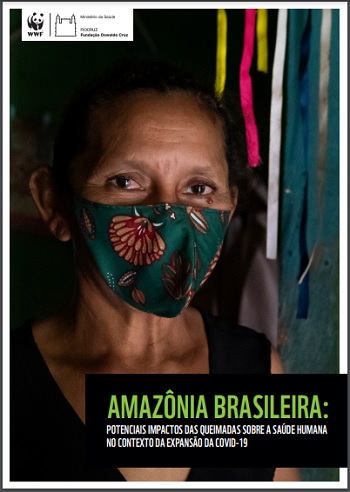Wildfires in the Amazon increase respiratory problems
30/04/2021
 A study by Fiocruz and WWF-Brasil shows that the wildfires in the Amazon were responsible for the increase in the percentages of hospitalizations due to respiratory problems in the last 10 years (2010-2020) in states with higher numbers of hot spots: Pará, Mato Grosso, Rondônia, Amazonas and Acre. These hospitalizations cost the public treasury almost 1 billion. The survey also points out that the association of the pandemic situation with forest wildfires in the Amazon may have aggravated the health situation of the legal Amazon population, because the pollutants from the wildfires can cause a persistent inflammatory response and, thus, increase the risk of infection by viruses that reach the respiratory tract.
A study by Fiocruz and WWF-Brasil shows that the wildfires in the Amazon were responsible for the increase in the percentages of hospitalizations due to respiratory problems in the last 10 years (2010-2020) in states with higher numbers of hot spots: Pará, Mato Grosso, Rondônia, Amazonas and Acre. These hospitalizations cost the public treasury almost 1 billion. The survey also points out that the association of the pandemic situation with forest wildfires in the Amazon may have aggravated the health situation of the legal Amazon population, because the pollutants from the wildfires can cause a persistent inflammatory response and, thus, increase the risk of infection by viruses that reach the respiratory tract.
The study shows that even with the possible underreporting, due to inconsistencies in the DataSUS database, the daily values of pollutants are extremely high and contributed to increase by up to twice the risk of hospitalization for respiratory diseases attributable to the concentration of fine breathable and inhalable particles (smoke) in the analyzed States. In the Amazon, 87% of hospital admissions in the period analyzed are related to high concentrations of smoke. The percentage was 68% in Pará and 70% in Mato Grosso and, also, in Rondônia. In turn, the respiratory diseases associated with the high concentrations of pollutant particles emitted by the wildfires account for 70% of the hospital admissions recorded in Pará, Mato Grosso, Rondônia and Amazonas.
Researcher Sandra Hacon, of the National School of Public Health (Ensp/Fiocruz), says that although the percentages of hospitalization for respiratory diseases in the region remained stable between 2010 and 2020, a considerable part of these hospitalizations can be attributed to concentrations of fine breathable and inhalable particles emitted by forest wildfires. “The microparticles that make up the smoke are deposited in the cavities of the lungs, aggravating respiratory problems. They are a risk factor for people who already have comorbidities. We see, therefore, an impact on the health and loss of the well-being quality of people, in addition to the high economic cost of respiratory diseases for SUS”, she explains. “The weakening of the respiratory system is extremely worrying in the current scenario of a pandemic that also causes respiratory problems. This overlap suggests that the legal Amazon region will tend to have its health system pressed, since the wildfires are more intense in the months of drought, which begin within a few weeks”, she warns.
In 2020, Brazil reached the highest number of wildfires in the decade. According to the Brazilian Institute of Space Research (Inpe), the Amazon rainforest recorded 103,161 spots compared to 89,171 in 2019, an increase of 15.7%. According to the Director of Conservation and Restoration of WWF-Brazil, Edegar de Oliveira, this continuous trend of destruction directly impacts not only people’s health, but the whole ecosystem, which suffers every year during the intensified cycle of wildfires in the dry season. “The fires are part of the dynamics of destruction of the Amazon. The deforested areas are subsequently burned to “clear” the terrain, making room for pasture, agriculture, or simple land speculation. The association between deforestation, wildfires and forest degradation carries a very high cost for all of us, especially the forest peoples, and for the planet’s climate”, he says.
The study brings some recommendations to the public authorities: the official systems of surveillance and monitoring in health need systematic evolution and improvements, especially those directed to the indigenous populations of the Amazon; consistent policies to reduce deforestation and wildfires in the Amazon are critical and immediate, because the fight against deforestation and degradation of the Amazon biome is fundamental to the guarantee of basic rights of local populations, such as access to health, and a healthy and sustainable environment; development and implementation of effective epidemiological and environmental surveillance programs aimed at the population of the Amazon exposed to forest wildfires, especially the most vulnerable groups, such as pregnant women, children, the elderly, and those people with comorbidities need dedicated attention; and the imminent need for preventive effort to control zoonoses, because the costs associated with preventive efforts are substantially lower, if compared to the economic, social and health costs involved in controlling potential epidemics and/or pandemics.


